With the cost of housing around Knoxville, Tennessee rising, elected officials and political candidates are looking for new ways to allow residential density.

Knoxville Mayor Mayor Indya Kincannon is expected to proposed zoning changes that would make it easier to build missing middle housing.
Silas Sloan reports that the mayor is focusing on residential density as the cost of housing around the Eastern Tennessee continues to rise.
“Kincannon told Knox News the proposed changes are based on a fall 2022 housing landscape study conducted by Opticos Design, a zoning reform consultancy hired by the city and Knoxville-Knox County Planning to identify solutions to the housing crunch,” writes Sloan.
Opticos Senior Associate Tony Perez is quoted in the article saying that vague and outdated language in Knoxville’s zoning code makes it difficult to develop missing middle housing.
“The proposed changes, created in partnership with East Tennessee Realtors, should be presented to the Knoxville City Council and Knoxville-Knox County Planning Commission this fall, Kincannon said, with a goal of finalizing the changes by January 2024,” reports Sloan.
Sloan also adds that R. Bentley Marlow, a developer who is running for the city's council's at-large seat B, has proposed another set of zoning changes that would allow missing middle housing a permitted development, or by-right development, in residential neighborhoods, rather than a special use.
Zoning reforms have been developing in Tennessee for a few years now as the state deals with swift growth and surging housing costs. Nashville reformed its parking requirements, setting parking maximums, in November 2022, for an example of a city achieving legislative reform prior to Knoxville’s explorations of missing middle housing.
FULL STORY: Knoxville's housing crisis could get help by easing path to build duplexes and townhomes [paywall]

Study: Maui’s Plan to Convert Vacation Rentals to Long-Term Housing Could Cause Nearly $1 Billion Economic Loss
The plan would reduce visitor accommodation by 25,% resulting in 1,900 jobs lost.

North Texas Transit Leaders Tout Benefits of TOD for Growing Region
At a summit focused on transit-oriented development, policymakers discussed how North Texas’ expanded light rail system can serve as a tool for economic growth.

Why Should We Subsidize Public Transportation?
Many public transit agencies face financial stress due to rising costs, declining fare revenue, and declining subsidies. Transit advocates must provide a strong business case for increasing public transit funding.

How to Make US Trains Faster
Changes to boarding platforms and a switch to electric trains could improve U.S. passenger rail service without the added cost of high-speed rail.

Columbia’s Revitalized ‘Loop’ Is a Hub for Local Entrepreneurs
A focus on small businesses is helping a commercial corridor in Columbia, Missouri thrive.

Invasive Insect Threatens Minnesota’s Ash Forests
The Emerald Ash Borer is a rapidly spreading invasive pest threatening Minnesota’s ash trees, and homeowners are encouraged to plant diverse replacement species, avoid moving ash firewood, and monitor for signs of infestation.
Urban Design for Planners 1: Software Tools
This six-course series explores essential urban design concepts using open source software and equips planners with the tools they need to participate fully in the urban design process.
Planning for Universal Design
Learn the tools for implementing Universal Design in planning regulations.
City of Santa Clarita
Ascent Environmental
Institute for Housing and Urban Development Studies (IHS)
City of Grandview
Harvard GSD Executive Education
Toledo-Lucas County Plan Commissions
Salt Lake City
NYU Wagner Graduate School of Public Service





























